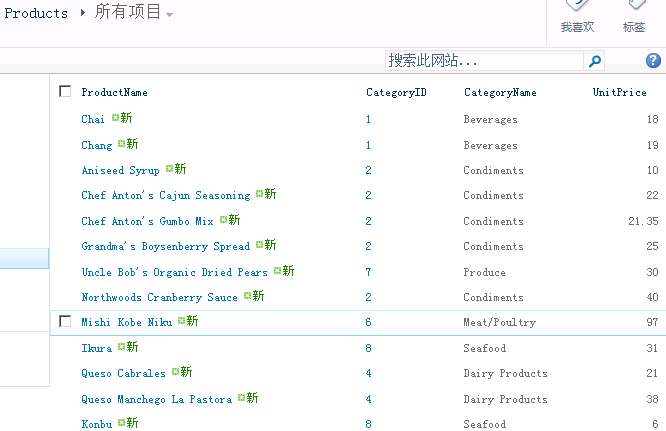SharePoint2010 对象模型 关联列表
有关列表的创建其实网上已经有很多文章了,其中练习 :利用Visual Studio 2010创建列表这篇文章个人感觉还不错,这里我强调的是对象模型来创建。在这之前我插入一点其他的东东,导入电子表格和数据表视图中的自定义列表。
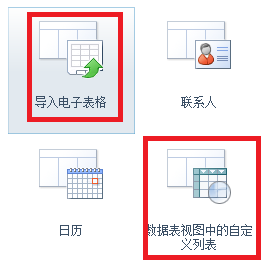
创建“导入电子表格列表”
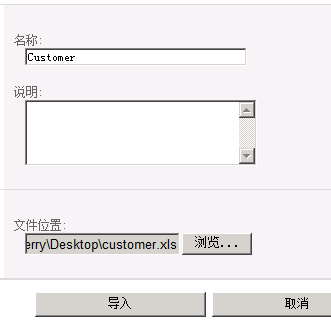
单击“导入”
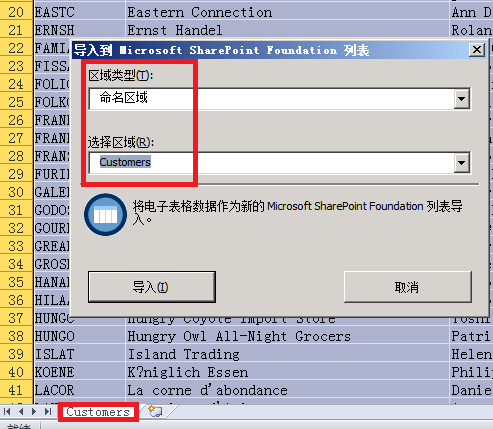
单击“导入”
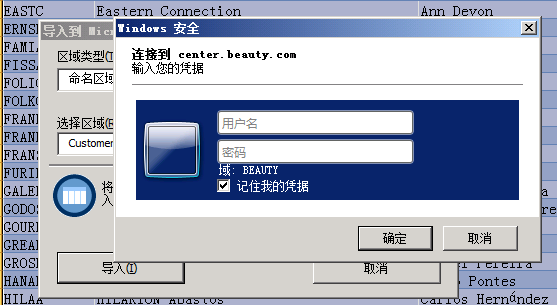

这些列名称不好用 我们需要修改为我们自己的列名称
修改前
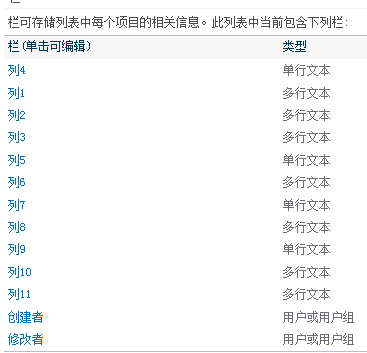
修改后:
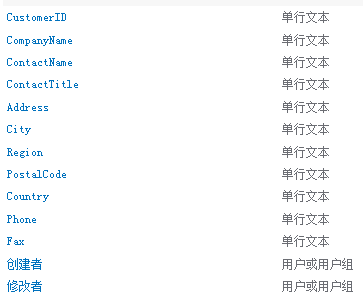

我们启用 视图的直接编辑属性

现在看看数据的编辑


这个编辑是不是很简单啊。
数据表视图中的自定义列表 这个没什么好说的,主要是数据浏览很好用,如果你和我一样用的是office64的话,会用“未安装与 Microsoft SharePoint Foundation 兼容的数据表组件”错误

需要安装“AccessDatabaseEngine.exe”来解决。
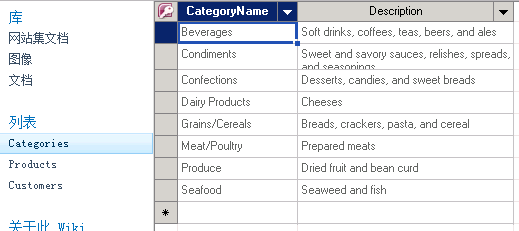
这个页面是不是很好 编辑数据啊。
SharePoint中还有一个外部列表,这里有比较详细的介绍:
http://www.cnblogs.com/chenxizhang/archive/2010/05/01/1725531.html
http://www.cnblogs.com/chenxizhang/archive/2010/05/01/1725576.html
http://www.cnblogs.com/chenxizhang/archive/2010/05/01/1725711.html
现在切换到我们的正题 “关联列表” ,相信大家对Northwind数据库比较熟悉,这里我们用Categories和Products表来演示关联关系。
首先 列表的创建代码 很简单 如下:
Guid id = web.Lists.Add("Categories", string.Empty, SPListTemplateType.GenericList);
SPList list = web.Lists[id];
列表 列的创建也很简单 如下:
string fieldname = list.Fields.Add("Description", SPFieldType.Text, true);
SPField field = list.Fields.GetFieldByInternalName("Description");
大家都应该知道sharepoint自定义列表由很多预定义好的列,典型的就是 ID(编号) 和Title(标题),这里Categories和Products都有自增长字段,用这个ID
来做是在好不过了。
field = list.Fields["ID"];
field.Title = "CategoryID";
field.StaticName = "CategoryID";
field.Update();
还有在我们列表默认有一个 “所有项目”的视图,该视图有一个附件列,这里我们需要移除它。
SPView view = list.Views.OfType<SPView>().FirstOrDefault(x => x.DefaultView);
SPViewFieldCollection viewFields = view.ViewFields;
//附件
SPField field = list.Fields.GetFieldByInternalName("Attachments");
viewFields.Delete(field);
创建Categories列表如下:
public static void CreateCategories()
{
SPSecurity.RunWithElevatedPrivileges(() =>
{
using (SPSite site = new SPSite(siteUrl))
{ using (SPWeb web = site.RootWeb)
{
bool originalupdate = web.AllowUnsafeUpdates;
web.AllowUnsafeUpdates = true;
Guid id = web.Lists.Add("Categories", string.Empty, SPListTemplateType.GenericList);
SPList list = web.Lists[id];
SPView view = list.Views.OfType<SPView>().FirstOrDefault(x => x.DefaultView);
SPViewFieldCollection viewFields = view.ViewFields;
//附件
SPField field = list.Fields.GetFieldByInternalName("Attachments");
viewFields.Delete(field); field = list.Fields["ID"];
field.Title = "CategoryID";
field.StaticName = "CategoryID";
field.Update();
// viewFields.Add(field); field = list.Fields.GetFieldByInternalName("Title");
field.Title = "CategoryName";
field.StaticName = "CategoryName";
field.EnforceUniqueValues = true;
field.Indexed = true;
field.Update(); string fieldname = list.Fields.Add("Description", SPFieldType.Text, true);
field = list.Fields.GetFieldByInternalName("Description");
viewFields.Add(field); list.OnQuickLaunch = true;
view.Update();
list.Update();
//web.Update();
web.AllowUnsafeUpdates = originalupdate;
}
}
});
}
创建关联列我们需要用到SPFieldLookup对象,它需要指定关联那个列表那个列,具体实现如下:
SPList categorList = web.Lists.TryGetList("Categories");
string fieldname = list.Fields.AddLookup("CategoryID", categorList.ID, true);
SPFieldLookup categoryID = list.Fields.GetFieldByInternalName(fieldname) as SPFieldLookup;
categoryID.Required = true;
categoryID.Indexed = true;
categoryID.LookupField = "ID";// categorList.Fields["CategoryID"].InternalName;
categoryID.RelationshipDeleteBehavior = SPRelationshipDeleteBehavior.Cascade;
categoryID.Update();
viewFields.Add(categoryID);
这里指定关联到Categories列表的CategoryID列(内部名称是ID),关联行为 是级联删除。 我们还可以添加依赖的列,依赖列需要指定那个关联列和查找列
fieldname = list.Fields.AddDependentLookup("CategoryName", categoryID.Id);
SPFieldLookup categoryName = (SPFieldLookup)list.Fields.GetFieldByInternalName("CategoryName");
categoryName.LookupField = "Title";// categorList.Fields["标题"].InternalName;
viewFields.Add(categoryName);
categoryName.Update();
Products列表创建代码 如下:
public static void CreateProducts()
{ SPSecurity.RunWithElevatedPrivileges(() =>
{
using (SPSite site = new SPSite(siteUrl))
{ using (SPWeb web = site.RootWeb)
{
bool originalupdate = web.AllowUnsafeUpdates;
web.AllowUnsafeUpdates = true;
Guid id = web.Lists.Add("Products", string.Empty, SPListTemplateType.GenericList);
SPList list = web.Lists[id];
SPView view = list.Views.OfType<SPView>().FirstOrDefault(x => x.DefaultView);
SPViewFieldCollection viewFields = view.ViewFields;
//Remove Attachments
SPField field = list.Fields.GetFieldByInternalName("Attachments");
viewFields.Delete(field); field = list.Fields.GetFieldByInternalName("ID");
field.Title = "ProductID";
field.StaticName = "ProductID";
field.Update();
// viewFields.Add(field); field = list.Fields.GetFieldByInternalName("Title");
field.Title = "ProductName";
field.StaticName = "ProductName";
field.EnforceUniqueValues = true;
field.Indexed = true;
field.Update(); SPList categorList = web.Lists.TryGetList("Categories");
string fieldname = list.Fields.AddLookup("CategoryID", categorList.ID, true);
SPFieldLookup categoryID = list.Fields.GetFieldByInternalName(fieldname) as SPFieldLookup;
categoryID.Required = true;
categoryID.Indexed = true;
categoryID.LookupField = "ID";// categorList.Fields["CategoryID"].InternalName;
categoryID.RelationshipDeleteBehavior = SPRelationshipDeleteBehavior.Cascade;
categoryID.Update();
viewFields.Add(categoryID); fieldname = list.Fields.AddDependentLookup("CategoryName", categoryID.Id);
SPFieldLookup categoryName = (SPFieldLookup)list.Fields.GetFieldByInternalName("CategoryName");
categoryName.LookupField = "Title";// categorList.Fields["标题"].InternalName;
viewFields.Add(categoryName);
categoryName.Update(); fieldname = list.Fields.Add("UnitPrice", SPFieldType.Number, true);
SPFieldNumber numberfield = list.Fields[fieldname] as SPFieldNumber;
numberfield.DisplayFormat = SPNumberFormatTypes.TwoDecimals;
viewFields.Add(numberfield);
field.Update(); list.OnQuickLaunch = true;
view.Update();
list.Update();
//web.Update();
web.AllowUnsafeUpdates = originalupdate;
}
}
}); }
现在列表已经创建好了,我们需要相应的代码来做删除操作,这里Categories原本可以直接删除,可是Products关联它的,所以必须先删除Products列表才能删除Categories,而Products列表中有关联列,默认是不能直接删除该列表,所以在删除列表前必须先删除相应的关联列,并且在删除关联列前也必须先删除依赖列,具体实现如下:
public static void DeleteList(string listname)
{ SPSecurity.RunWithElevatedPrivileges(() =>
{
using (SPSite site = new SPSite(siteUrl))
{ using (SPWeb web = site.RootWeb)
{
SPList list = web.Lists.TryGetList(listname);
if (list == null) return;
SPFieldLookup[] lookupFields = list.Fields.OfType<SPFieldLookup>().Where(c => c.IsRelationship).ToArray();
if (lookupFields != null && lookupFields.Count()>)
{
foreach (SPFieldLookup field in lookupFields)
{
SPFieldLookup[] depentFields = list.Fields.OfType<SPFieldLookup>().Where(c => c.IsDependentLookup && c.PrimaryFieldId == field.Id.ToString()).ToArray();
foreach (SPFieldLookup item in depentFields)
{
item.Delete();
}
field.Delete();
}
}
list.Delete();
web.Update();
}
}
});
}
现在需要向这2个列表导入数据,这个就没什么特别
SPListItem item = list.Items.Add();
item["CategoryName"] = row["CategoryName"].ToString();
item["Description"] = row["Description"].ToString();
item.SystemUpdate();
导入数据后 列表如图:
现在该说查询的事情,关联查询需要用到SPQuery的Joins和ProjectedFields属性,这2个属性这里不是很好设置,我做这个demo在这个花费了4个小时都没搞定,最后用ling来实现,把相应的caml拷贝出来才实现该功能。
/*
* 不过Joins 和ProjectedFields 对于字段有很多限制,join的表不支持多行文本,不支持用户或用户组
SPQuery查询列表查不出结果,提示“一个或多个域类型未正确安装。请转到列表设置页删除这些域”。
原因: 查询的时候,字段名称需要输入字段的内部(InternalName)名称,而不是显示名称(DisplayName)。
*/
SPList list = web.Lists.TryGetList("Products");
SPQuery query = new SPQuery();
query.Query = @"<Where>
<And>
<BeginsWith>
<FieldRef Name='ContentTypeId' />
<Value Type='ContentTypeId'>0x0100</Value>
</BeginsWith>
<Gt>
<FieldRef Name='UnitPrice' />
<Value Type='Number'>30</Value>
</Gt>
</And>
</Where>";
query.Joins = @"<Join Type='LEFT' ListAlias='CategoryID'>
<Eq>
<FieldRef Name='CategoryID' RefType='ID'/>
<FieldRef List='CategoryID' Name='ID' />
</Eq>
</Join>";
query.ProjectedFields = @"<Field Name='CategoryTitle' Type='Lookup' List='CategoryID' ShowField='Title' />
<Field Name='CategoryDescription' Type='Lookup' List='CategoryID' ShowField='Description' />";
query.ViewFields = @" <FieldRef Name='ID' />
<FieldRef Name='Title' />
<FieldRef Name='UnitPrice' />
<FieldRef Name='CategoryTitle' />
<FieldRef Name='CategoryDescription' />";
query.RowLimit = 10;
SPListItemCollection items = list.GetItems(query);
在joins里面<FieldRef List='CategoryID' Name='ID' />这句我不知道我们非要写成CategoryID(Products里面的关联列名),而不是Categories(关联的列表名称),网上也没有找到相应的说明。如果大家有人知道原因还请赐教一下。个人建议用Linq to SharePoint来实现关联查询(用它来生成这里的caml也可以啊)。
完整的代码如下:
public partial class Programs
{
static string siteUrl = "http://center.beauty.com/sites/wiki/"; public static void DeleteList(string listname)
{ SPSecurity.RunWithElevatedPrivileges(() =>
{
using (SPSite site = new SPSite(siteUrl))
{ using (SPWeb web = site.RootWeb)
{
SPList list = web.Lists.TryGetList(listname);
if (list == null) return;
SPFieldLookup[] lookupFields = list.Fields.OfType<SPFieldLookup>().Where(c => c.IsRelationship).ToArray();
if (lookupFields != null && lookupFields.Count()>)
{
foreach (SPFieldLookup field in lookupFields)
{
SPFieldLookup[] depentFields = list.Fields.OfType<SPFieldLookup>().Where(c => c.IsDependentLookup && c.PrimaryFieldId == field.Id.ToString()).ToArray();
foreach (SPFieldLookup item in depentFields)
{
item.Delete();
}
field.Delete();
}
}
list.Delete();
web.Update();
}
}
});
}
public static void CreateCategories()
{
SPSecurity.RunWithElevatedPrivileges(() =>
{
using (SPSite site = new SPSite(siteUrl))
{ using (SPWeb web = site.RootWeb)
{
bool originalupdate = web.AllowUnsafeUpdates;
web.AllowUnsafeUpdates = true;
Guid id = web.Lists.Add("Categories", string.Empty, SPListTemplateType.GenericList);
SPList list = web.Lists[id];
SPView view = list.Views.OfType<SPView>().FirstOrDefault(x => x.DefaultView);
SPViewFieldCollection viewFields = view.ViewFields;
//附件
SPField field = list.Fields.GetFieldByInternalName("Attachments");
viewFields.Delete(field); field = list.Fields["ID"];
field.Title = "CategoryID";
field.StaticName = "CategoryID";
field.Update();
// viewFields.Add(field); field = list.Fields.GetFieldByInternalName("Title");
field.Title = "CategoryName";
field.StaticName = "CategoryName";
field.EnforceUniqueValues = true;
field.Indexed = true;
field.Update(); string fieldname = list.Fields.Add("Description", SPFieldType.Text, true);
field = list.Fields.GetFieldByInternalName("Description");
viewFields.Add(field); list.OnQuickLaunch = true;
view.Update();
list.Update();
//web.Update();
web.AllowUnsafeUpdates = originalupdate;
}
}
});
}
public static void CreateProducts()
{ SPSecurity.RunWithElevatedPrivileges(() =>
{
using (SPSite site = new SPSite(siteUrl))
{ using (SPWeb web = site.RootWeb)
{
bool originalupdate = web.AllowUnsafeUpdates;
web.AllowUnsafeUpdates = true;
Guid id = web.Lists.Add("Products", string.Empty, SPListTemplateType.GenericList);
SPList list = web.Lists[id];
SPView view = list.Views.OfType<SPView>().FirstOrDefault(x => x.DefaultView);
SPViewFieldCollection viewFields = view.ViewFields;
//Remove Attachments
SPField field = list.Fields.GetFieldByInternalName("Attachments");
viewFields.Delete(field); field = list.Fields.GetFieldByInternalName("ID");
field.Title = "ProductID";
field.StaticName = "ProductID";
field.Update();
// viewFields.Add(field); field = list.Fields.GetFieldByInternalName("Title");
field.Title = "ProductName";
field.StaticName = "ProductName";
field.EnforceUniqueValues = true;
field.Indexed = true;
field.Update(); SPList categorList = web.Lists.TryGetList("Categories");
string fieldname = list.Fields.AddLookup("CategoryID", categorList.ID, true);
SPFieldLookup categoryID = list.Fields.GetFieldByInternalName(fieldname) as SPFieldLookup;
categoryID.Required = true;
categoryID.Indexed = true;
categoryID.LookupField = "ID";// categorList.Fields["CategoryID"].InternalName;
categoryID.RelationshipDeleteBehavior = SPRelationshipDeleteBehavior.Cascade;
categoryID.Update();
viewFields.Add(categoryID); fieldname = list.Fields.AddDependentLookup("CategoryName", categoryID.Id);
SPFieldLookup categoryName = (SPFieldLookup)list.Fields.GetFieldByInternalName("CategoryName");
categoryName.LookupField = "Title";// categorList.Fields["标题"].InternalName;
viewFields.Add(categoryName);
categoryName.Update(); fieldname = list.Fields.Add("UnitPrice", SPFieldType.Number, true);
SPFieldNumber numberfield = list.Fields[fieldname] as SPFieldNumber;
numberfield.DisplayFormat = SPNumberFormatTypes.TwoDecimals;
viewFields.Add(numberfield);
field.Update(); list.OnQuickLaunch = true;
view.Update();
list.Update();
//web.Update();
web.AllowUnsafeUpdates = originalupdate;
}
}
}); } public static void ImportData()
{
string constr = "Data Source=192.168.1.21;Initial Catalog=Northwind;Integrated Security=SSPI;";
string sql = "SELECT CategoryName, Description FROM Categories";
DataTable dt = new DataTable();
using (SqlConnection con = new SqlConnection(constr))
{
SqlDataAdapter ap = new SqlDataAdapter(sql, con);
ap.Fill(dt);
}
SPList list;
using (SPSite site = new SPSite(siteUrl))
{
using (SPWeb web = site.RootWeb)
{
list = web.Lists.TryGetList("Categories");
foreach (DataRow row in dt.Rows)
{
SPListItem item = list.Items.Add();
item["CategoryName"] = row["CategoryName"].ToString();
item["Description"] = row["Description"].ToString();
item.SystemUpdate();
} }
} //add Products
sql = "SELECT ProductName, CategoryID, UnitPrice FROM Products";
dt = new DataTable();
using (SqlConnection con = new SqlConnection(constr))
{
SqlDataAdapter ap = new SqlDataAdapter(sql, con);
ap.Fill(dt);
}
using (SPSite site = new SPSite(siteUrl))
{
using (SPWeb web = site.RootWeb)
{
list = web.Lists.TryGetList("Products");
foreach (DataRow row in dt.Rows)
{
SPListItem item = list.Items.Add();
item["ProductName"] = row["ProductName"].ToString();
item["CategoryID"] = int.Parse(row["CategoryID"].ToString());
item["UnitPrice"] = double.Parse(row["UnitPrice"].ToString());
item.SystemUpdate();
} }
}
}
public static void GetListItems()
{ SPSecurity.RunWithElevatedPrivileges(() =>
{
using (SPSite site = new SPSite(siteUrl))
{ using (SPWeb web = site.RootWeb)
{
try
{
//var context = new NwindDataContext(siteUrl); //var qry = from p in context.Products
// where p.标题 == "demo"
// select new { ProductID = p.Id, Title = p.标题, UnitPrice = p.UnitPrice, CategoryName = p.CategoryID.标题, Description = p.CategoryID.Description };
//context.Log = Console.Out;
//var result = qry.ToList(); /*
* 不过Joins 和ProjectedFields 对于字段有很多限制,join的表不支持多行文本,不支持用户或用户组
SPQuery查询列表查不出结果,提示“一个或多个域类型未正确安装。请转到列表设置页删除这些域”。
原因: 查询的时候,字段名称需要输入字段的内部(InternalName)名称,而不是显示名称(DisplayName)。
*/
SPList list = web.Lists.TryGetList("Products");
SPQuery query = new SPQuery();
query.Query = @"<Where>
<And>
<BeginsWith>
<FieldRef Name='ContentTypeId' />
<Value Type='ContentTypeId'>0x0100</Value>
</BeginsWith>
<Gt>
<FieldRef Name='UnitPrice' />
<Value Type='Number'>30</Value>
</Gt>
</And>
</Where>"; query.Joins = @"<Join Type='LEFT' ListAlias='CategoryID'>
<Eq>
<FieldRef Name='CategoryID' RefType='ID'/>
<FieldRef List='CategoryID' Name='ID' />
</Eq>
</Join>";
query.ProjectedFields = @"<Field Name='CategoryTitle' Type='Lookup' List='CategoryID' ShowField='Title' />
<Field Name='CategoryDescription' Type='Lookup' List='CategoryID' ShowField='Description' />";
query.ViewFields = @" <FieldRef Name='ID' />
<FieldRef Name='Title' />
<FieldRef Name='UnitPrice' />
<FieldRef Name='CategoryTitle' />
<FieldRef Name='CategoryDescription' />";
query.RowLimit = ;
SPListItemCollection items = list.GetItems(query);
foreach (SPListItem item in items)
{
string productID = item["ProductID"].ToString();
string productionname = item["ProductName"].ToString();
string unitePrice = item["UnitPrice"].ToString();
string categoryName = new SPFieldLookupValue(item["CategoryTitle"].ToString()).LookupValue;
string categoryDescription = new SPFieldLookupValue(item["CategoryDescription"].ToString()).LookupValue;
Console.WriteLine(string.Format("ProductID={0},ProductName={1},CategoryName={2},UnitPrice={3}",
productID, productionname, categoryName, unitePrice));
} }
catch (Exception ex)
{ throw;
}
}
}
});
}
}
}
public partial class Programs
{
static void Main(string[] args)
{
DeleteList("Products");
DeleteList("Categories");
CreateCategories();
CreateProducts();
ImportData();
GetListItems(); }
}
SharePoint2010 对象模型 关联列表的更多相关文章
- sharepoint2010 创建自定义列表
转:http://boke.25k5.com/kan77298.html 如何创建自定义列表 首先了解创建自定义列表中涉及到的几个名词:栏.内容类型. ①栏:栏即列.字段(Field),MSDN中给出 ...
- 匿名用户访问sharepoint2010中的列表
Allow anonymous users to access listitems on a publishing site in SharePoint 2010 https://knowledge. ...
- 客户端对象模型之列表数据导出到Excel
1,废话不多话,直接上代码,留着以后做类似功能时Copy一下!有需要的朋友也可以参考一下. <!DOCTYPE html> <html xmlns="http://www. ...
- Sharepoint 列表
1.将SharePoint 2010列表数据使用Access打开 在SharePoint 2010新增加了对列表在Access客户端的打开,可以在Microsoft Access 中处理列表中的项目, ...
- 【SharePoint学习笔记】第3章 SharePoint列表新特性以及数据访问
第3章 SharePoint列表新特性以及数据访问 使用CAML查询语言 CAML:协作应用程序标记语言 Collaboration Application Markup Language ...
- 使用NPOI生成Excel级联列表
目录 1 概要 1 2 磨刀不误砍柴工——先学会Excel中的操作 2 3 利用NPOI生成导入模板 7 3.1 设置workbook&sheet ...
- 更快实现Android多级树形选择列表
快速实现Android多级树形列表,这个库是在鸿洋多级树形列表demo中修改而来. 解决的问题: 1. 支持ID为int类型和String类型. 2. 支持多级复选框选中,使用只需一行代码. 3. 支 ...
- discuz功能列表
导航旁边的+就可以把其加入到常用操作 上 首页 管理中心首页 文件校验,在线成员,管理团队留言.系统信息.开发 团队介绍. 常用操作管理 名称和URL 全局 站点信息 站点名称.网站名称,网站URL. ...
- C#:列表视图操作类
using System; using System.Collections.Generic; using System.Linq; using System.Text; using System.W ...
随机推荐
- 循序渐进学.Net Core Web Api开发系列【16】:应用安全续-加密与解密
系列目录 循序渐进学.Net Core Web Api开发系列目录 本系列涉及到的源码下载地址:https://github.com/seabluescn/Blog_WebApi 一.概述 应用安全除 ...
- 减少Building 'Xxx' Gradle project info等待时间
转载请注明出处:http://www.cnblogs.com/cnwutianhao/p/6640279.html 从Github上看到好的Demo想要Download下来学习.导入到Android ...
- 20172319 实验四 《Android程序设计》实验报告
20172319 2018.05.17-30 实验四<Android程序设计> 实验报告 课程名称:<程序设计与数据结构> 学生班级:1723班 学生姓名:唐才铭 学生学号:2 ...
- 内核调试神器SystemTap 转摘
http://blog.csdn.net/zhangskd/article/details/25708441 https://sourceware.org/systemtap/wiki/WarStor ...
- C#实现路由器断开连接,更改公网ip
publicstaticvoid Disconnect() { string url ="断 线"; string uri ="http://192.168.1.1 ...
- Cocos2d-x3.1TestCpp之NewRenderTest Demo分析
1.代码构成 VisibleRect.h VisibleRect.cpp AppDelegate.h AppDelegate.cpp HelloWorldScene.h HelloWorldScene ...
- delphi shr和shl的作用
x:=x shl 1 二进制数向左移1位,尾部补1个零,相当于x:=x*2;x:=x shl 2 二进制数向左移2位,尾部补2个零,相当于x:=x*4;...x:=x shl n 二进制数向左移n位, ...
- 在Visual Studio中开发一个C语言程序
→新建一个项目→选择"其他语言","Visual C++",并选择"win32控制台应用程序",并给控制台应用程序起名.→点击"下 ...
- Maven 使用了一个标准的目录结构和一个默认的构建生命周期。
Maven 使用了一个标准的目录结构和一个默认的构建生命周期. 约定优于配置 当创建 Maven 工程时,Maven 会创建默认的工程结构.开发者只需要合理的放置文件,而在 pom.xml 中不再需要 ...
- C#编程(十四)----------构造函数
原文链接:http://blog.csdn.net/shanyongxu/article/details/46501683 构造函数 所谓的构造函数就是和类名重名的且没有返回值的方法. class P ...


